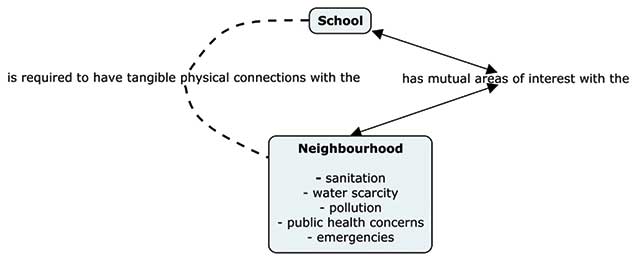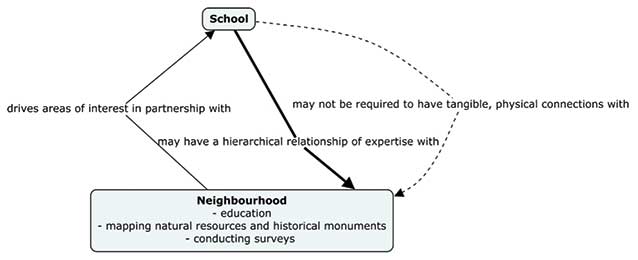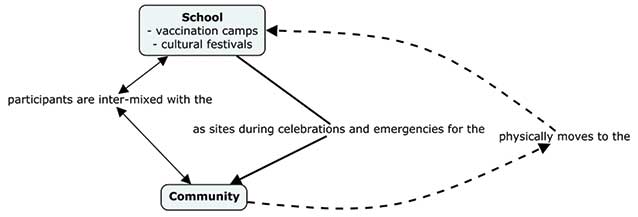Sindhu Mathai
Schools and neighbourhoods are required to own a relationship of responsiveness, and support. Schools being the nerve centres of neighbourhoods are necessarily linked with the surrounding environment and communities from where children and teachers are often drawn. Educational experiments in India taking the form of ‘alternative’ schooling have practised these through synergistic interactions and ways of living.
Krishnamurti viewed schools as torchbearers, laying directions for society to rid itself of petty despair and narrow living. Communities in mutual inquiry are involved in this shared work of education in the schools he developed. Inner transformation then is part of a journey supported by ecological engagement with surrounding areas enriched by local and contextual knowledge (Thapan, 2001). Gandhi (1968) imagined productive work through the learning of a locally significant handicraft to be the locus of a curriculum that is responsive to the needs of the community. The questions emerging from different ‘subjects’ and a history of disciplines are then woven into this process meaningfully. Tagore’s abiding questions on the rationale for education required mutual co-existence with other living beings in nature. This lent itself to a discernment of the ‘outside’ as dwelling within learning through classes held in the open. Tagore emphasized ‘intimacy’ as a counterpart to the hierarchical and instrumental relationship that existed between an educational institution and the surrounding village (Datta, 2022). Eklavya’s experimental approach to science teaching in schools drew from Paulo Freire’s vision of critical enquiry and conscientisation of the community in the search for a meaningful science curriculum and pedagogic practices in rural areas (Paliwal, 2022). Phule’s attempts at education of girls as a social reformer further reinforced these connections between prevalent social categories and its reflection in the classroom (Venkatesh, 2016). Aurobindo’s larger questions about a life affirming integral education imagined a community brought together, as part of the neighbourhood that was supportive of this inquiry and search (Majumdar, 2017).
This short article takes a somewhat different path, it points to ways in which schools and neighbourhoods could be mapped or characterized. Simple characterizations help understand and articulate spatial relationships in the school’s surrounding areas. Spatial relationships can be understood through the coexistence of communities, surrounding natural areas and objects through relative organization and imaginations of goals for such relationships.
Goals for school-neighbourhood relationships
Neighbourhoods could be characterized based on communities which co-exist with schools and surrounding physical landscapes. Participants from the school may include children, teachers, other school employees and the school management. What might be meaningful goals that schools and neighbourhoods may pursue together? Some possibilities could be:
- Mutual areas of interest where the school and neighbourhood work together to improve issues in the area such as sanitation, water scarcity, pollution, public health, and others.
- Areas of interest primarily driven by the needs of the neighbourhood such as education of children from the neighbourhood, mapping natural resources and historical monuments in the area, conducting surveys to understand public health concerns, funding requirements from the school or the larger trust or organization it is affiliated to for development projects, and so on, requiring expertize from the school.
- Developing leadership in the community, such as among youth, primarily through efforts from the school in taking up significant work in the neighbourhood which could also be of mutual interest.
- Managing special education contexts in the community which require support from the school such as engagement with children of migrant labourers or managing informal learning centres.
- Conducting and observing significant days and events in the neighbourhood where the school is the site, such as for vaccination camps, elections, local festivals, children’s day events, and other cultural celebrations.
We may employ some considerations for spatial mapping to understand the structure of these mentioned relationships and also comment on future directions that may be meaningful or desirable.
Mapping spatial relationships
Spatial relationships could be mapped using certain criteria:
Order refers to the structure of spatial relationships between schools and neighbourhoods. These relationships could be linear, branching (arboreal or tree-like), rhizomatic through horizontal multi-directional branching patterns, and cyclical. While inferences could be made about spatial relationships based on these structures, goals could inform about the kinds of relationships that are desirable. The temporal order of occurrence of events also suggests patterns.
Connection in the form of tangible, physical connections between schools and neighbourhoods, or categorical connections through themes of mutual interest.
Metaphorical descriptions are suggestive of related forms, representations, structures or processes which may evoke a combination of spatial characteristics and imagination of the directionality in the relationship.
For the first goal mentioned previously, order and connection may be mapped as represented in Figure 1, where mutual relationships exist between schools and communities. A tangible, physical connection is required to be present between the school and the neighbourhood to be able to carry out shared activities.

For Goal 2, there is a strong direction of influence from the school to the community in terms of expertize in the events being organized and represented with a stronger line of relationship in Figure 2. However, the neighbourhood drives these areas of interest which the school carries forward, allocating resources and particular roles for school participants. Where expertize is involved, there may not be a tangible physical connection between the school and the neighbourhood. However, some ideational, thematic connection exists which could also be a spatial relationship.

Developing leadership in the community within the third goal is a ‘mid-way path’, where the school’s influence is critical. A community newly empowered with this developed expertize is now able to take on challenges confronting the neighbourhood. Directions of flow towards this centre are interesting as represented in Figure 3.

To implement the fourth goal, the neighbourhood provides educational contexts through which the school can contribute as well as learn, represented through bi-directional arrows as shown in Figure 4. This is, for example, through the education of children of migrant labourers and in informal or non-formal learning contexts. While the school with its formal curricular structure and history of implementation will be able to provide support through typical education programmes as mentioned in the first goal, here special education contexts spin new challenges requiring careful execution.

For the fifth goal, the school becomes a site for the community during significant events determined by the larger system such as for elections and vaccination camps, but also through festivals and cultural events where the community physically moves to the school, or as clear participants with belonging to both the school and neighbourhood, overlapping interestingly as shown in Figure 5.

Concluding thoughts…
The discussed ways of characterizing schools and neighbourhoods are useful in understanding the goals of evolving relationships. They also help visualize other kinds of meaningful relationships. Mapping them articulates the vision, besides bringing forth dominant directions in our conceptualisation, as emergent from the arrows in the represented figures. While the school may come to be the hub of activity and expertize, our imagination should also consider the community in such privileged roles. Further reflection on its value through metaphorical descriptions also communicates structure, direction, and required emphasis in decision-making.
References
• Datta, P.K. (2022). Sriniketan: inter-embedded pedagogy and transformation of the rural. In Nair, J. (Ed.) Un/Common Schooling. Educational experiments in twentieth century India. Hyderabad: Orient Blackswan Pvt. Ltd.
• Gandhi, M.K. (1968). Buniyadi Shiksha Basic Education. From The Selected Works of Mahatma Gandhi: The Voice of Truth. Volume 6. Ahmedabad: Navajivan Publishing House.
• Majumdar, A. (2017). The city beneath a banyan tree. The Hindu, 19th November 2017.
• Paliwal, R. (2022). Eklavya’s work in and around government schools: resistance, resilience and impact. In Nair, J. (Ed.) Un/Common Schooling. Educational experiments in twentieth century India. Hyderabad: Orient Blackswan Pvt. Ltd.
• Thapan, M. (2001). J. Krishnamurti (1895-1986). Prospects: the quarterly review of comparative education Vol. XXXI, no. 2, June 2001, pp.273-286. UNESCO, Paris: International Bureau of Education.
• Venkatesh, K. (2016). Education for Liberation: Exploring Mahatma Phule’s Work in Education. Contemporary Education Dialogue 13(1) 121-144.
The author is a faculty member at the School of Education, Azim Premji University, Bengaluru since 2011. Her areas of interest include science education, curriculum studies and research methodologies, and she has taught courses in these areas to students in the M.A. Education programme. This article draws from preliminary work as part of a collaborative project on space-time relationships in the classroom. She can be reached at sindhu.mathai@apu.edu.in.
